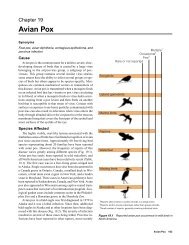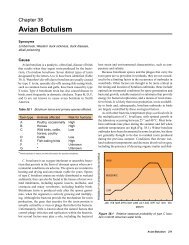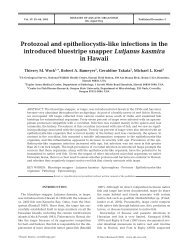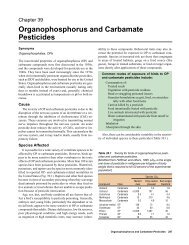Biowarfare, Bioterrorism, and Animal Diseases as Bioweapons
Biowarfare, Bioterrorism, and Animal Diseases as Bioweapons
Biowarfare, Bioterrorism, and Animal Diseases as Bioweapons
You also want an ePaper? Increase the reach of your titles
YUMPU automatically turns print PDFs into web optimized ePapers that Google loves.
Between 1936 <strong>and</strong> 1980, more than 100 definitions for<br />
terrorism were coined. 110 Within the USA, two official definitions<br />
of terrorism have been used since the early 1980s; the<br />
Department of State uses one for accounting purposes (statistical<br />
<strong>and</strong> analytical endpoints), <strong>and</strong> the U.S. Congress uses<br />
the other for criminal proceedings (“act of terrorism”). 57 The<br />
context of bioterrorism within this chapter follows a recent<br />
definition in the scientific literature <strong>and</strong> is separated from<br />
biowarfare on the b<strong>as</strong>is of the latter involving a declaration of<br />
war or the perception of war being waged between nations <strong>as</strong><br />
evidenced by an appropriate level of hostile actions between<br />
nations. Keeping that distinction in mind, “<strong>Bioterrorism</strong><br />
is the intentional use of microorganisms or toxins derived<br />
from living organisms to cause death or dise<strong>as</strong>e in humans,<br />
animals, or plants on which we depend.” 77<br />
P<strong>as</strong>t <strong>Biowarfare</strong> <strong>and</strong> <strong>Bioterrorism</strong><br />
“A man may imagine things that are false, but he can only<br />
underst<strong>and</strong> things that are true.” (Isaac Newton) 2<br />
The ravages of naturally occurring dise<strong>as</strong>e documented<br />
throughout history 2,6–11 substantiate infectious dise<strong>as</strong>e use <strong>as</strong><br />
potential weapons among enemies. In fact, biological warfare<br />
w<strong>as</strong> used in varying degrees well before the germ theory for<br />
dise<strong>as</strong>e w<strong>as</strong> first proposed in 1530, 12 demonstrating that infectious<br />
dise<strong>as</strong>e used <strong>as</strong> weapons against humans <strong>and</strong> animals<br />
is not a new concept. 13–16<br />
Plague <strong>and</strong> Smallpox <strong>as</strong> <strong>Bioweapons</strong><br />
The 1346 Siege of Caffa (also spelled Kaffa, which is<br />
now Feodosija, Ukraine) involved the most gruesome <strong>and</strong><br />
crudest example of biological warfare when the Mongol<br />
army catapulted plague-infected cadavers into the besieged<br />
city. “Mountains of dead were thrown into the city,” infecting<br />
the inhabitants <strong>and</strong> resulting in many deaths from the<br />
Black Death (plague). However, plague also dev<strong>as</strong>tated the<br />
Mongols attacking the city <strong>and</strong> the infected cadavers did not<br />
alter the outcome of the siege. Furthermore, fleeing survivors<br />
were not a major factor in plague spreading from Caffa to the<br />
Mediterranean B<strong>as</strong>in because of other factors contributing to<br />
the plague epidemic. 16,17<br />
Plague is a zoonotic dise<strong>as</strong>e caused by the bacterium Yersinia<br />
pestis, typically harbored by wild rodents (Fig. 6.2). The<br />
plague epidemic that swept through Europe, the Near E<strong>as</strong>t,<br />
<strong>and</strong> North Africa in the mid-14 th century w<strong>as</strong> probably the<br />
greatest public health dis<strong>as</strong>ter in recorded history. An estimated<br />
one-quarter to one-third of Europe’s population died<br />
from plague during the 14 th century p<strong>and</strong>emic, <strong>and</strong> North<br />
Africa, the Near E<strong>as</strong>t, <strong>and</strong> perhaps the Far E<strong>as</strong>t had similar<br />
high levels of mortality. 16,18 However, the first recorded plague<br />
p<strong>and</strong>emic began in 541 in Egypt when the world population<br />
w<strong>as</strong> considerably smaller <strong>and</strong> decimated an even greater<br />
percentage of the population. This p<strong>and</strong>emic swept across<br />
234 Dise<strong>as</strong>e Emergence <strong>and</strong> Resurgence: The Wildlife–Human Connection<br />
Europe <strong>and</strong> parts of Asia; between 50 <strong>and</strong> 60 percent of the<br />
human population died in many are<strong>as</strong>. 19,20<br />
Given the explosive nature <strong>and</strong> history of dise<strong>as</strong>e spread<br />
over wide are<strong>as</strong>, plague could be a dangerously effective<br />
biological weapon 18,20, 21 <strong>and</strong> nations pursuing bioweapons<br />
development have often focused on this agent. During World<br />
War II (WWII), Japan successfully initiated plague epidemics<br />
in China by rele<strong>as</strong>ing <strong>as</strong> many <strong>as</strong> 15 million laboratoryinfected<br />
fle<strong>as</strong> per attack from aircraft over Chinese cities. 22,23<br />
Nevertheless, the complexity of biological factors involved<br />
in plague transmission results in fle<strong>as</strong> being unreliable <strong>as</strong> a<br />
delivery system for biowarfare.<br />
Early in the history of the Black Death, the original<br />
bubonic-flea-borne variety of plague evolved to the far more<br />
contagious pneumonic variety <strong>as</strong> a cause of human epidemics.<br />
1 Direct human exposure by aerosolized plague bacilli is<br />
the most effective way to cause human illness <strong>and</strong> death; 19,24,25<br />
the biological weapons programs of the USA <strong>and</strong> the former<br />
Soviet Union have pursued aerosol transmission capabilities<br />
for plague. 19,26,27 The Soviets had intercontinental ballistic<br />
missile warheads containing plague bacilli available for<br />
launch before 1985. 28 Yet, virtually insurmountable problems<br />
arose in the production <strong>and</strong> aerosol dispersal of substantial<br />
quantities of plague organisms by modern weapon systems. 29<br />
Despite these difficulties, plague is viewed <strong>as</strong> a high-risk<br />
dise<strong>as</strong>e for bioweapons. 32<br />
Smallpox also h<strong>as</strong> intentionally been used against humans.<br />
Unlike plague, smallpox is strictly a dise<strong>as</strong>e of humans;<br />
it is not zoonotic (Fig. 6.3). 30 In 1763, during the Pontiac<br />
Rebellion (Indian Wars) in North America, contaminated<br />
blankets <strong>and</strong> a h<strong>and</strong>kerchief from a smallpox hospital were<br />
given <strong>as</strong> gifts by British forces to Native Americans. This<br />
Trojan horse approach introduced the smallpox virus into<br />
the tribes <strong>and</strong> caused major c<strong>as</strong>ualties. 17,22,31 Capabilities for<br />
aerosol exposure of humans to smallpox exist, while access<br />
to the virus remains tightly controlled following global<br />
eradication of this dise<strong>as</strong>e during the 1970s. World Health<br />
Assembly resolution WHA 52.10 called for the destruction<br />
of all remaining stocks of the smallpox virus by the end of<br />
2002, but further evaluation by the World Health Organization<br />
concluded that live virus w<strong>as</strong> needed for specific scientific<br />
purposes. That position w<strong>as</strong> supported by the World Health<br />
Assembly. 208 Virus stocks are maintained for that purpose in<br />
the USA <strong>and</strong> Russia under international oversight.<br />
Other Applications of <strong>Bioweapons</strong> Targeting Humans<br />
Numerous reports of using dise<strong>as</strong>e <strong>as</strong> a bioweapon during<br />
times of war exist, but few can be confirmed from available<br />
records. For various re<strong>as</strong>ons, information about the use of<br />
these weapons <strong>and</strong> their consequences often are unavailable.<br />
From 1932 through WWII, Japan clearly had the most<br />
aggressive biological warfare program ever applied at the<br />
field level. 14,23 This program resulted in the estimated deaths<br />
of at le<strong>as</strong>t 10,000 people in laboratory experiments (prisoners

















